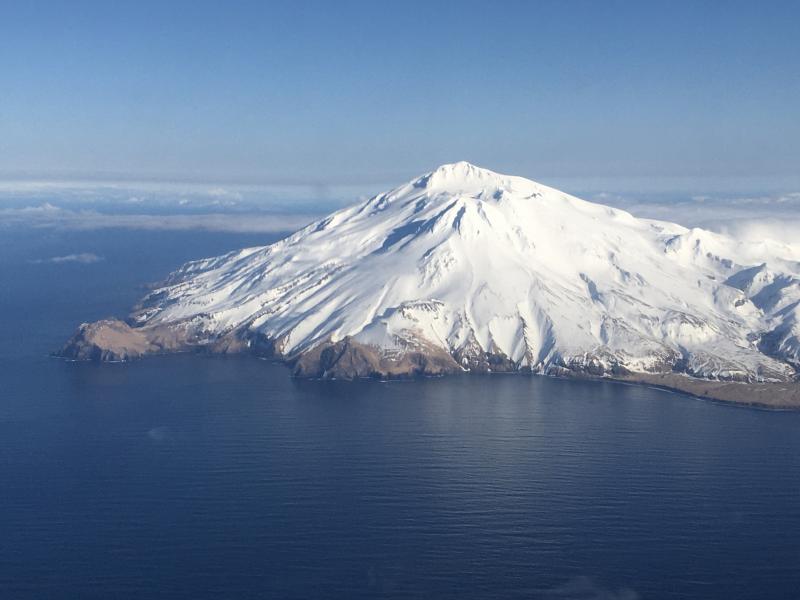
With additional volcanic explosions possible , the United States Geological Survey (USGS) and their Alaska Volcano Observatory (AVO) have raised the advisory level and color code to a higher level at the Great Sitkin Volcano.
The Great Sitkin Volcano is a basaltic andesite volcano that occupies most of the northern half of Great Sitkin Island, a member of the Andreanof Islands group in the central Aleutian Islands. It’s located roughly 26 miles east of Adak, which is 1,192 miles southwest of Anchorage. According to the AVO, the volcano has a composite structure consisting of an older dissected volcano and a younger parasitic cone with a 1.8 mile diameter summit crater. A steep-sided lava dome, emplaced during an eruption in 1974, occupies the center of the crater. Within the past 280 years, a large explosive eruption here produced pyroclastic flows that partially filled the Glacier Creek valley on the southwest flank.
The Great Sitkin Volcano is located along the “Ring of Fire”, which is a region around the rim of the Pacific Ocean where many volcanic eruptions and earthquakes occur. Caused by plate tectonics, lithospheric plates under and around the Pacific Ocean move, collide, and/or are destroyed, creating the seismic activity the Ring of Fire is famous for.
Volcanoes in this portion of the Ring of Fire are monitored by the Alaska Volcano Observatory (AVO), which is a joint program of the U.S. Geological Survey (USGS), the Geophysical Institute of the University of Alaska Fairbanks (UAFGI), and the State of Alaska Division of Geological and Geophysical Surveys (ADGGS). The AVO is similar to the Hawaii Volcano Observatory (HVO) which monitors Hawaii’s three active volcanoes: Kilauea, Mauna Loa, and Hualalai. In the case of AVO, they monitor Cleveland, Semisopochnoi, and Veniaminof too.
Alaska is home to many volcanoes, though; there are more than 130 volcanoes and volcanic fields which have been active within the geologically young last 2 million years. 50 have been active since the mid 1700s and AVO studies those too.
AVO is responsible for issuing Aviation Codes and Volcanic Activity Alert Levels. Aviation Codes are green, yellow, orange, or red. When ground-based instrumentation is insufficient to establish that a volcano is at a typical background level of activity, it is simply “unassigned.” While green means typical activity associated with a non-eruptive state, yellow means a volcano is exhibiting signs of elevated unrest above known background levels. When a volcano exhibits heightened or escalating unrest with the increased potential of eruption, it jumps to orange. Finally, when an eruption is imminent with significant emission of volcanic ash expected in the atmosphere or an eruption is underway with significant emission of volcanic ash into the atmosphere, the code becomes red. Volcanic Activity Alert levels are normal, advisory, watch, or warning. As with aviation codes, if data is insufficient, it is simply labeled as “unassigned.” When the volcano is at typical background activity in a non-eruptive state, it is considered normal. If the volcano exhibits signs of elevated unrest above background level, an advisory is issued. If a volcano exhibits heightened or escalating unrest, a watch is issued while a warning is issued when a hazardous eruption is imminent.
For now, the AVO has declared the Aviation Color Code to be “ORANGE” and the Volcano Alert Level to be “WATCH” at the volcano. According to the AVO, “A satellite radar image from last night July 22, 9:32 PM shows a small ~50 m (~150 ft) diameter area of uplift in the center of the crater at Great Sitkin suggestive of rising magma near the surface. This lava dome-like feature appears to have been emplaced sometime between July 14 and 22. ” AVO added, “Moderately elevated surface temperatures consistent with this feature were observed in satellite data on July 22. Cloudy conditions have obscured views of the volcano by satellite most of the past week. AVO will continue to closely monitor this new uplift feature.”
What happens next remains up in the air, or in this case, down underground. AVO scientists say they expect additional growth of the lava dome feature, perhaps accented by additional explosive volcanic events. “AVO will report on significant changes and observations in monitoring data should they occur,” AVO concluded today’s Volcano Observatory Notice for Aviation.”